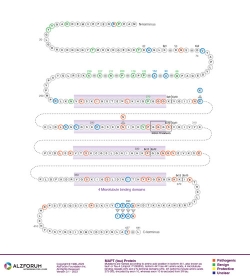Mutations
MAPT Q336H
Quick Links
Overview
Pathogenicity: Frontotemporal Dementia : Pathogenic, Pick's disease : Pathogenic
Clinical
Phenotype: Pick's disease
Reference Assembly: GRCh37/hg19
Position: Chr17:44095994 G>C
dbSNP ID: NA
Coding/Non-Coding: Coding
DNA
Change: Substitution
Expected RNA
Consequence: Substitution
Expected Protein
Consequence: Missense
Codon
Change: CAG to CAC
Reference
Isoform: Tau Isoform Tau-F (441 aa)
Genomic
Region: Exon 12
Findings
This mutation was identified in a man with neuropathologically confirmed Pick's disease (Tacik et al., 2015). He died at age 63, eight years after symptom onset. He first presented with deficits in short-term memory and personality changes with disinhibition. He later developed speech hesitancy, word-finding difficulties, and parkinsonism, including bradykinesia, rigidity, and an unsteady gait. Clinically, he was diagnosed with atypical Alzheimer’s disease with parkinsonism. In addition to carrying the Q336H mutation, he was homozygous for the H1 MAPT haplotype. He had a positive family history for early-onset neurodegenerative disease. His mother had a similar clinical syndrome and died at age 65. His maternal uncle had been diagnosed with Alzheimer’s disease. Genetic and neuropathological analyses were not available for these two family members.
Neuropathology
The mutation carrier met neuropathological criteria for Pick's disease. Postmortem examination showed focal cortical atrophy and frequent well-characterized Pick bodies in the upper cortical layers. Pick bodies were cytoplasmic neuronal inclusions that were largely negative for Gallyas silver stain. They were immunopositive for 3R tau (tau isoforms containing three microtubule-binding repeat domains); a minority contained 4R tau. Tau protein within Pick bodies was arranged in randomly oriented straight filaments with a diameter of 10 to 15 nm, with a few larger twisted filaments.
Pick cells, called “swollen achromatic neurons” or “ballooned neurons,” were frequent in the middle and lower neocortical layers of the frontal and temporal lobes.
Biological Effect
In vitro, the Q336H mutation facilitated tau binding to microtubules and promoted microtubule polymerization. Compared with wild-type tau protein, mutant 3R and 4R tau proteins were associated with faster microtubule polymerization and higher steady-state levels of polymerization.
The Q336H mutation also promoted tau filament assembly compared with wild-type tau. This effect was observed for both 3R and 4R isoforms, but was greater for 3R tau. Therefore, the mutation may affect the aggregation of 3R tau more strongly, consistent with the observation that Pick bodies are largely comprised of 3R tau.
Last Updated: 30 Oct 2015
References
Paper Citations
- Tacik P, DeTure M, Hinkle KM, Lin WL, Sanchez-Contreras M, Carlomagno Y, Pedraza O, Rademakers R, Ross OA, Wszolek ZK, Dickson DW. A Novel Tau Mutation in Exon 12, p.Q336H, Causes Hereditary Pick Disease. J Neuropathol Exp Neurol. 2015 Nov;74(11):1042-52. PubMed.
Further Reading
No Available Further Reading
Protein Diagram
Primary Papers
- Tacik P, DeTure M, Hinkle KM, Lin WL, Sanchez-Contreras M, Carlomagno Y, Pedraza O, Rademakers R, Ross OA, Wszolek ZK, Dickson DW. A Novel Tau Mutation in Exon 12, p.Q336H, Causes Hereditary Pick Disease. J Neuropathol Exp Neurol. 2015 Nov;74(11):1042-52. PubMed.
Other mutations at this position
Alzpedia
Disclaimer: Alzforum does not provide medical advice. The Content is for informational, educational, research and reference purposes only and is not intended to substitute for professional medical advice, diagnosis or treatment. Always seek advice from a qualified physician or health care professional about any medical concern, and do not disregard professional medical advice because of anything you may read on Alzforum.


Comments
No Available Comments
Make a Comment
To make a comment you must login or register.